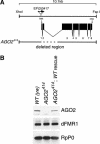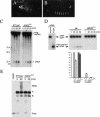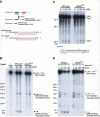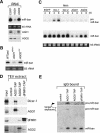Distinct roles for Argonaute proteins in small RNA-directed RNA cleavage pathways
- PMID: 15231716
- PMCID: PMC478188
- DOI: 10.1101/gad.1210204
Distinct roles for Argonaute proteins in small RNA-directed RNA cleavage pathways
Abstract
In mammalian cells, both microRNAs (miRNAs) and small interfering RNAs (siRNAs) are thought to be loaded into the same RNA-induced silencing complex (RISC), where they guide mRNA degradation or translation silencing depending on the complementarity of the target. In Drosophila, Argonaute2 (AGO2) was identified as part of the RISC complex. Here we show that AGO2 is an essential component for siRNA-directed RNA interference (RNAi) response and is required for the unwinding of siRNA duplex and in consequence assembly of siRNA into RISC in Drosophila embryos. However, Drosophila embryos lacking AGO2, which are siRNA-directed RNAi-defective, are still capable of miRNA-directed target RNA cleavage. In contrast, Argonaute1 (AGO1), another Argonaute protein in fly, which is dispensable for siRNA-directed target RNA cleavage, is required for mature miRNA production that impacts on miRNA-directed RNA cleavage. The association of AGO1 with Dicer-1 and pre-miRNA also suggests that AGO1 is involved in miRNA biogenesis. Our findings show that distinct Argonaute proteins act at different steps of the small RNA silencing mechanism and suggest that there are inherent differences between siRNA-initiated RISCs and miRNA-initiated RISCs in Drosophila.
Copyright 2004 Cold Spring Harbor Laboratory Press ISSN
Figures






References
-
- Bartel D.P. 2004. MicroRNAs: Genomics, biogenesis, mechanism, and function. Cell 116: 281-297. - PubMed
-
- Bernstein E., Caudy, A.A., Hammond, S.M. and Hannon, G.J. 2001. Role for a bidentate ribonuclease in the initiation step of RNA interference. Nature 409: 363-366. - PubMed
-
- Brennecke J, Hipfner, D.R, Stark, A, Russell, R.B., and Cohen, S.M. 2003. bantam encodes a developmentally regulated microRNA that controls cell proliferation and regulates the proapoptotic gene hid in Drosophila. Cell 113: 25-36. - PubMed
Publication types
MeSH terms
Substances
LinkOut - more resources
Full Text Sources
Other Literature Sources
Molecular Biology Databases
Research Materials
